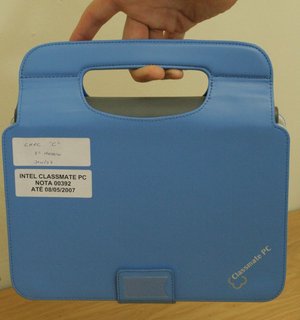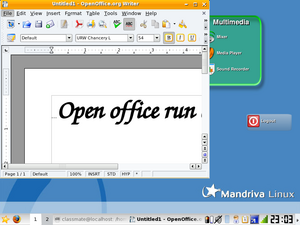Ars Technica recently got its hands on the new Intel Classmate laptop computer, one of the new projects competing for a share of school-aged computer users in developing countries. I was able to survey this machine thanks to Helio Chissini de Castro of Mandriva.
The unit I looked at was powered by a specialized version of Mandriva 2007, with customizations aimed at school-aged children. It was packed with several free, open-source productivity programs such as OpenOffice.org, and included a number of customizations to make the KDE-powered interface easier to use for those with limited computer experience. Support for open-source software for these systems will reduce the price, but there are other advantages as well. Schools and governments will be able to modify the Classmate PC software to meet their needs.
The hardware consisted of a number of Intel-powered chips, ranging from the Intel Celeron 900 processor to the Intel Mobile graphics and wireless chipsets. It was loaded up with 256MB of RAM, which in my usage was more than enough for powering Mandriva. The internal NAND flash drive for storage is only 1GB in size, but that was more than enough for the machine. In fact, Mandriva was also handing out Linux installations on USB flash drives, and it seemed to me that the Mandriva installation on the Classmate PC was more or less the same thing. With the exception of the battery monitor applet reporting the charge incorrectly, every element of this system was fully supported by open source Linux drivers.
The machine booted fairly quickly, or at least as quickly as a computer using a Celeron 900 chip can boot. It may have actually been faster than a typical laptop of this speed on account of the fact that there were no hard-disk seeking delays from the flash disk.
The form factor of the computer is indeed small. It's like a small text book with a handle attached to the back side of the computer. There were no ports at the back of the computer, only on the sides. It was not particularly heavy and would be comparable to carrying around two or three paperback novels. The fact that it comes with a soft handle makes it much more comfortable to carry.
The Classmate PC also contained two USB ports, one on each side, as well as an RJ45 Ethernet port and two audio jacks. These ports are not covered in any way, and considering its proposed usage scenarios, manufacturers should consider adding covers to keep the internals nice and clean.
The highly compact keyboard was difficult to type on for an adult since the keys are smaller than normal, presumably optimized for a child's hands. Using the circular touch pad was not a hindrance and felt fairly smooth. The screen had a resolution of 800 by 480 pixels, low by the standards of a modern computer, but the screen was usable for word processing. Since most web pages are no longer optimized for only 800 pixels of width, web browsing might be more challenging. However, the color and quality of the screen was good, and higher resolution may not even be desirable, given that the screen size is only about 7 inches across.
The screen seemed durable. The only changes made to Mandriva to accommodate the screen size were to default to smaller icons and use a style that reduced the width or height of certain interface elements such as the window titles and scroll bars to provide a little extra real estate. The company also provided a set of program launchers for the desktop to make launching the most common applications straightforward for the target audience.
Overall, I was very impressed with this effort. The computer was fast enough to run even the more power-hungry applications, and the speed at which programs launched from the flash drive was quite good. OpenOffice loaded in a reasonable time, but for impatient children who don't need Microsoft Word compatibility, perhaps KOffice would be a better solution.
Lastly, I was reviewing this system in a Glasgow pub, and the patrons of the pub were very interested in seeing the Classmate PC in operation. This system has the potential to succeed and is already being tested for classroom use in Brazil and other places. Whether or not this same system could run Windows well or not remains to be seen, but the Mandriva install fits the bill rather well.




reader comments